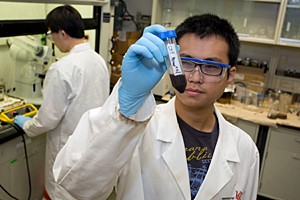
Researchers Read the Coffee Grounds and Find a Promising Energy Resource For the Future
For many of us, its the fuel that wakes us up and gets us started on our day. Now, University of Cincinnati researchers are discovering that an ingredient in our old coffee grounds might someday serve as a cheaper, cleaner fuel for our cars, furnaces and other energy sources.
Yang Liu, a graduate student in environmental engineering in UCs College of Engineering and Applied Science (CEAS), presents a summary of early-but-promising discoveries on his teams research at the American Chemical Societys (ACS) 246th National Meeting & Exposition this week in Indianapolis.
Liu and fellow researchers Qingshi Tu, a UC doctoral student in environmental engineering, and Mingming Lu, a UC associate professor of environmental engineering, used a three-pronged approach to converting waste coffee grounds into energy sources including biodiesel and activated carbon by:
- Extracting oil from the waste.
- Drying the waste coffee grounds after oil removal to filter impurities in biodiesel production.
- Burning what was left as an alternative energy source for electricity, similar to using biomass.
The researchers launched the project in 2010, gathering waste coffee grounds in a five-gallon bucket from a Starbucks store on UCs campus. After collection, they removed the oil from the waste coffee grounds and converted triglycerides (oil) into biodiesel and the byproduct, glycerin. The coffee grounds were then dried and used to purify the biodiesel they derived from the waste coffee grounds.
The preliminary results showed that the oil content in the waste coffee grounds was between 8.37-19.63 percent, and biodiesel made from coffee oil meets the ASTM International D6751 standard. The efficiency of using the waste coffee grounds as a purification material to remove the impurities in crude biodiesel, such as methanol and residual glycerin, was slightly lower compared with commercial purification products. However, the researchers report that results still indicate a promising alternative, considering the cost of purification products. Future research will continue to focus on improving the purification efficiency of waste coffee grounds-derived activated carbon.
Compared with petroleum diesel, the cleaner-burning biodiesel reduces the emission of carbon monoxide, hydrocarbons and particulate matters (PM).
Waste coffee grounds that result from brewing one of the worlds most popular beverages is estimated to result in more than one million tons per year in the U.S. alone, with the majority of that waste getting dumped into landfills.

Qingshi Tu, Mingming Lu and Yang Liu
The researchers say the method theyre exploring to produce biodiesel would not only open landfill space, but it also holds promise in creating biodiesel from a natural product thats not also in high demand as a food source, such as corn and soybean crops that are used to manufacture biodiesel.
The project was among four proposals selected for a $500 grant last spring from the
an enterprise led by UC Student Government and the UC student chapter of the Association for Computing Machinery to share ideas and encourage innovation in campus life.
Related Stories
OTR mural celebrates UC alumni success
April 4, 2025
The UC Alumni Association, UCAA, will mark its annual Alumni Celebration during its upcoming Alumni Week, April 7-13, with a community art project commemorating this year’s slate of alumni honorees receiving the organization’s top awards.
UC students combine engineering and design experience
April 3, 2025
At the University of Cincinnati, the College of Design, Art, Architecture and Planning hosted a design competition with HAAG-Streit USA, where students were tasked with designing an ophthalmology workstation that is accessible and able to be incorporated into retail settings. Caleb Loayza, a mechanical engineering student at the College of Engineering and Applied Science, and Guy Mueller, an industrial design student, combined their expertise and took home first place.
UC Honors students gain hands-on research experience
April 1, 2025
The Biomedical Research and Mentoring Program is open to any University Honors Program students. The faculty mentors are typically from UC’s College of Medicine or Cincinnati Children's Hospital.
